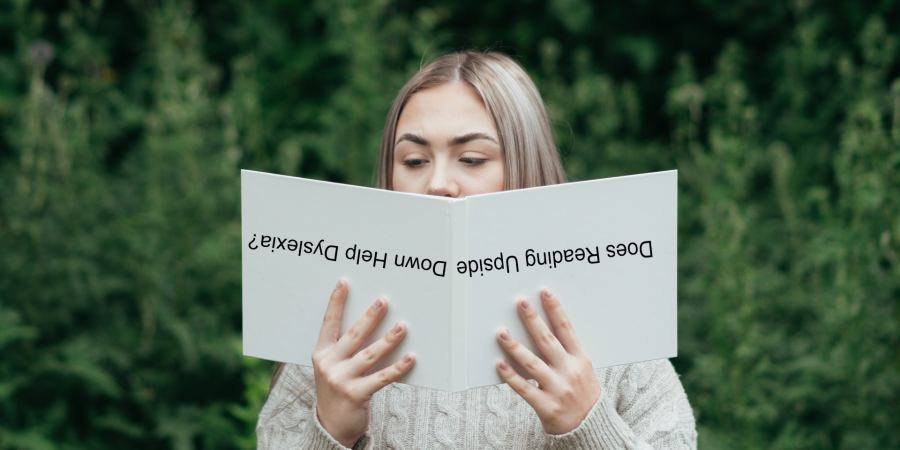Does Reading Upside Down Help Dyslexia?

There are plenty of people suffering from dyslexia, and some have spoken out about how it has affected their lives. It is also a condition that is not widely understood yet. When a person has dyslexia, they have trouble writing, spelling, and speaking. It is crucial for us to be more aware of this condition.
Reading upside down can help people with dyslexia. There have been studies that upside-down reading can help people read better and understand what they are reading better. With this position of reading, people can retain information better than reading the traditional way.
Dyslexia should not be taken lightly. This article will talk about whether reading upside can help a person that is dealing with dyslexia. I will also talk about how reading looks to a person with dyslexia, it is good for them to read upside, and other ways to help a person with dyslexia.
Does Reading Upside Down Help Dyslexia?
As per the National Library of Medicine, reading is an expert visual, and ocular motor function learned mainly in a single orientation. Now, in a study that was published in the Annals of Dyslexia, it was mentioned by Steen Larsen and Paul Perlenvi that they have proofreaders who can significantly better understand reading when the text is upside down.
The experiment was done on 46 poor readers and was compared with 20 normal control readers, where the subjects were second-grade children. The first experiment has two matching word lists presented under two conditions. These conditions are one version of the test and read it in the correct way, while the other upside down.
The second experiment was the eye movements of all subjects recorded during their reading of two meaningful sentences in both normal and upside-down positions. The test concluded that poor readers showed a slight tendency to read better in the upside-down position. The result also showed about 28.3 percent of the poor readers who read upside down improved performance at least 15 percent than those who read normally.
With this experiment done, people have been trying to teach people with dyslexia to read upside, and it has been shown that they can understand and read better when this is done. It may not make sense to children who are young of an age, but it is a habit that you can let them get used to so that they can read and understand what they are reading better.
With this being said, when you have detected dyslexia at an early phase, this method would take effect faster. Within less than a month, your child will learn how to read properly. The reason for this is there is still some sort of rewiring that takes place in the children’s brain at a young age.
In this case, they will learn faster and get over dyslexia in no time. With adults, however, it may take a little bit more time. Eventually, they will be able to read and understand better when they read their books upside down.
Ensure that you are determined to pay attention to your children and look for any signs of dyslexia. When you have found different signs, take your children to the doctor to know about the condition. Start at letting them read a book upside down so that you can help them overcome the condition of dyslexia.
What Does It Look Like to Read with Dyslexia?
People with dyslexia have a more challenging time reading. They would need a lot of concentration, and the letters may seem to ‘jump around’ during the time that they are reading a text or a book. There are six types of dyslexia that a person can have.
Phonological Dyslexia is often found in 75% of people who experience difficulty breaking speech into individual sounds. Now, every language has a set of common sounds that reuse it repeatedly in the form of words. People with the condition have no trouble producing and processing these sounds when they speak their native language. However, the difficulty comes when they make up a word.
Surface Dyslexia is also experienced by some people, which causes them to take longer to process a language when they move beyond the decoding stage. In the English language, not all words are spelled as their sound. This is where people have trouble seeing the whole word, which causes comprehension difficulties and can increase the required reading processing time.
Visual dyslexia has symptoms that often trouble reading and remember what they have seen on a page. As the name suggests, it impacts visual processing, which means the brain doesn’t receive the full picture of what the eyes are seeing. It has severe implications for learning to form letters and also mastering spelling. It can lead to someone not remembering the correct sequence of words in spelling.
Primary Dyslexia is a genetically inherited condition. This means that a child with a parent with dyslexia is more likely to have the same condition themselves. This type of dyslexia can cause difficulty in processing sounds, letters, and numbers. With this said, it can negatively impact a child’s ability in spelling, reading, and math.
Developmental Dyslexia is developed because of infections and sometimes poor nutrition in the womb, where some babies experience brain development issues. This can cause neurological impairment and the result of dyslexia. This type of dyslexia has been shown to respond best to treatment, including targeted phonics work through computer programs.
Lastly, Acquired Dyslexia is when an adult or child has a brain injury from trauma or disease. When a person has experienced this, it can sometimes lead to difficulties with language processing and results in a person having dyslexia.
When you notice your child experiencing some of the signs above, it is best to pay attention to it right away. At most times, dyslexia reveals itself at a young age. Some have preschool evaluations that can look at the child’s awareness of sounds that make up words and ability at word retrieval.
However, some doctors say you have to wait until children are at least six years old and have some formal reading instruction. When you notice a problem at this age, it is best to talk to a professional.
Is It Good to Read Upside Down?
As I have mentioned above, studies showing that reading upside down is better than reading the normal way. Reading upside down improves your memories of what you have read, according to a study done in 2011 in a study published in Psychonomic Bulletin and Review.
Also, upside-down reading is a skill where almost anyone can improve. In a study that was done in 2014, it was found that people who are reading upside down can read 35 words per minute over ten weeks. They only had 90 minutes a week to practice this technique of reading. Not only did it improve their reading rate, but it also improved their comprehension.
Though there have been experiments, it is still worth the try when the results can lead to positive outcomes for someone who has dyslexia. There are other ways to treat this condition, but it wouldn’t hurt to try having your child read upside down.
Other Ways to Help with Dyslexia
Research shows that dyslexia is more common in males, particularly those who are left-handed. Aside from getting used to reading upside down, there are other ways that you can help a person with dyslexia. It is best to know if your child has dyslexia as soon as possible. When you see signs such as trouble spelling or reading, make sure to take them to a doctor and have them checked for dyslexia.
The number one thing that you can help a child with dyslexia is to encourage them with activities that they like and feel good at, from music to joining a sports team to anything else that helps them build their confidence. It is also best to speak with people who are successful with overcoming dyslexia. This way, they can tell you their experiences and how they are able to overcome the condition.
Listening to audiobooks is one great way to help people with dyslexia. It can be an alternative to reading. Another is typing on a computer or tablet instead of writing can help them with their writing skills. You can also use other apps that can turn learning fun by turning decoding into a game. Lastly, using a ruler to help kids read in a straight link will help them focus more while reading.
Aside from activities, emotional support is also needed. People with dyslexia can result in frustration, embarrassment, and low-self esteem. This will result in difficulties performing tasks that seem to come naturally to others. You can help them by discussing the specific challenges that can result from dyslexia.
Make sure to acknowledge their efforts and celebrate any hard work they have done, even if they made mistakes. Help them recognize his strengths and beware of the negative self-talk. If they do this, make sure not to ignore it. Turn those negative self-talk into the positive and encouraging talk.






